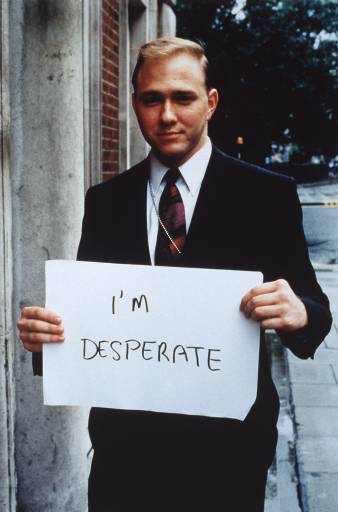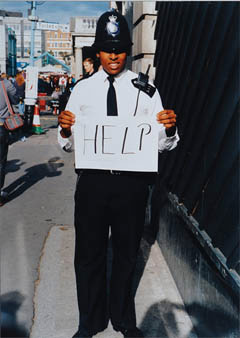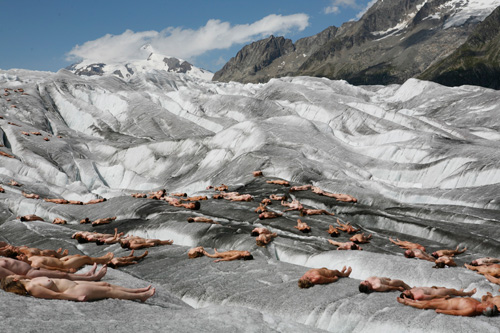The second and third picture below of the projected symbols and letters was puzzling at first when we first walked into the museum exhibit. There was one person on one side of a wall typing on a computer and another person on the other side of the wall typing on a computer. Then it became apparent that they were having a conversation like on AOL Instant Messenger; however, their conversation was not showing up on the projected screen as intelligible English but the conversation was represented by pictures and symbols. We decided to try having a conversation on the computer and it was very interesting to see how the sentence that you typed into the computer was translated to a symbolic language; it was a great game to try to figure out what the other was saying based on these symbols. It was interesting to see how easy it was to communicate in pictures and in other instances it was much more difficult to think differently about these symbols and pictures and translate them in my head into words and sentences, like it was a game of charades. Our conversation became a artwork in itself and it was a nice feeling to consider that we had contributed to the development of the exhibit.
The pictures of the text on the pieces of paper below were part of Lee Etheredge IV's optical art using a typewriter. All the pieces of paper had different designs which were created by manipulating the font size,darkness of the font, spacing, and placement. Many of his artworks are not formulated and he discovers the image only upon completion. He uses the type writer as a mark making tool to bridge between thought and order. When we first entered the exhibit it did not look like much was going on but with a deeper look the artworks sprang to life and we realized the meticulous work that these artists had to put into creating these designs. A majority of these artworks were created using a typewriter and this almost forgotten piece of technology was given a new meaning and a new way to make an impact on language and text through textual art.
I enjoyed this exhibit more than I initially thought I was going to; one just needed to take a deeper look.
What is Art?
Monday, November 29, 2010
Friday, November 26, 2010
Wednesday, November 24, 2010
Courier
The museum at the University of Albany is called 'Courier'. The museum consists of numerous works of art by artists who focus on the communiative and physical proporties of the typewriter. The message of the collection of artwork is that the typewriter, despite its obsolete status, has great importance in transmitting creative ideas. Its potential is explored through print, photography, film and installation artwork. The typewriter, for each artist in Courier, acts as a way to transform thoughts or ideas into new visual forms.
This picture is of a film playing in one of the rooms in the museum. It is called 'History of the Typewriter', created in 2009 by artist Ignacio Uriarte. It documents Michael Winslow, who is an actor and comedian. He created sound effects using his voice, recreating the mechanical sounds of the typewriter between 1870's to the 1980's. This art peice in my opinion was very creative and fun.
This piece was created by Matt Liddle, called 'Obsolete Tools for Everyday Communication', created in 2010. The picture shows unique properties of the IBM Selectric Typewriter. The colors the artist chose, make the piece look old and in fact obsolete. However, the artist is trying to show that each object has a distinctive purpose, allowing for everyday communication.
 This piece was one of my favorites at the Courier Museum. It is called 'Potamic Decreasing Space', by Lee Etheredge IV, created in 2010. His photographs combine contemporary photographs of Civil War battlefields, with songs about the Civil War, typed by a typewriter. When looked at closely, the artwork shows subtle, typed patterns of lyrics, which fall over the image of the Civil War battlefield. When first viewing the piece, its hard to tell that you are looking at lyrics, and it makes the scene appear more dark and depressing. However, the lyrics have a commemorative theme, which is contrasted by the gloominess of the photo. The lyrics discuss the soldiers detication to the war, and the honor they recieved. It represents the symbolic healing of the War. Once again this piece shows the potential such an obsolete object provides.
This piece was one of my favorites at the Courier Museum. It is called 'Potamic Decreasing Space', by Lee Etheredge IV, created in 2010. His photographs combine contemporary photographs of Civil War battlefields, with songs about the Civil War, typed by a typewriter. When looked at closely, the artwork shows subtle, typed patterns of lyrics, which fall over the image of the Civil War battlefield. When first viewing the piece, its hard to tell that you are looking at lyrics, and it makes the scene appear more dark and depressing. However, the lyrics have a commemorative theme, which is contrasted by the gloominess of the photo. The lyrics discuss the soldiers detication to the war, and the honor they recieved. It represents the symbolic healing of the War. Once again this piece shows the potential such an obsolete object provides.
This picture is of a film playing in one of the rooms in the museum. It is called 'History of the Typewriter', created in 2009 by artist Ignacio Uriarte. It documents Michael Winslow, who is an actor and comedian. He created sound effects using his voice, recreating the mechanical sounds of the typewriter between 1870's to the 1980's. This art peice in my opinion was very creative and fun.
This piece was created by Matt Liddle, called 'Obsolete Tools for Everyday Communication', created in 2010. The picture shows unique properties of the IBM Selectric Typewriter. The colors the artist chose, make the piece look old and in fact obsolete. However, the artist is trying to show that each object has a distinctive purpose, allowing for everyday communication.
 This piece was one of my favorites at the Courier Museum. It is called 'Potamic Decreasing Space', by Lee Etheredge IV, created in 2010. His photographs combine contemporary photographs of Civil War battlefields, with songs about the Civil War, typed by a typewriter. When looked at closely, the artwork shows subtle, typed patterns of lyrics, which fall over the image of the Civil War battlefield. When first viewing the piece, its hard to tell that you are looking at lyrics, and it makes the scene appear more dark and depressing. However, the lyrics have a commemorative theme, which is contrasted by the gloominess of the photo. The lyrics discuss the soldiers detication to the war, and the honor they recieved. It represents the symbolic healing of the War. Once again this piece shows the potential such an obsolete object provides.
This piece was one of my favorites at the Courier Museum. It is called 'Potamic Decreasing Space', by Lee Etheredge IV, created in 2010. His photographs combine contemporary photographs of Civil War battlefields, with songs about the Civil War, typed by a typewriter. When looked at closely, the artwork shows subtle, typed patterns of lyrics, which fall over the image of the Civil War battlefield. When first viewing the piece, its hard to tell that you are looking at lyrics, and it makes the scene appear more dark and depressing. However, the lyrics have a commemorative theme, which is contrasted by the gloominess of the photo. The lyrics discuss the soldiers detication to the war, and the honor they recieved. It represents the symbolic healing of the War. Once again this piece shows the potential such an obsolete object provides. Thursday, November 18, 2010
Andrea Zittel
Andrea Zittel attempts to talk about her own interpretation of the world through her art, while at the same time attempts to relate to people who share similar experiences and values. There is a sense of simpicity and freedom in her artwork. In her "A-Z Administrative Services", which consists of homes, furniture and vehicles, she focuses on human beings, and how they live and function. Human beings become the subject for all of her art pieces. She also makes her art an extension of herself, drawing from the imperfections in her life. She has produced numerous "living units", like the one shown here. Each unit becomes an environment in itself, containing everything a person needs to function. I dont think this is an attempt by the artist to create a more compact, efficient living area for people to use, but rather to simply anaylze everyday objects, giving off the idea that we live in a consumer-driven society.
Tuesday, November 16, 2010
Relational Art
Relational art is a type of art that was originally observed and highlighted by French art critic Nicolas Bourriaud; he defined this mode of fine art as" a set of artistic practices which take as their theoretical and practical point of departure the whole of human relations and their social context, rather than an independent and private space". Interactive or participatory art of various kinds emerged as a distinct and important strand within fine art practice in the 1990s. Arguably, it anticipated the rise of the Internet and reality TV, which, in the mainstream media are comparable phenomena, at least in the way they appear to flatten the hierarchy between consumer and producer.This type of art is allowed to grow and blossom in the audience that it is presented in. The goal is to make the audience the community and where onlookers of the art can interact with the shared activity. Artists such as Marcus Coates practices a form of relational art by tapping into the psych of animals to acquire knowledge from the earth. This knowledge is then translated to understand society and to relate to current issues. Moreover, relational art is seen in other forms by taking moments in current history and making them into works of art.
The above piece of art is an interactive piece where onlookers can change the lighting on the panel any way they wish. It is strange to consider this artwork because it looks like just a game; come to think of it interactive art is more common than I thought.
The above piece of art is an interactive piece where onlookers can change the lighting on the panel any way they wish. It is strange to consider this artwork because it looks like just a game; come to think of it interactive art is more common than I thought.
Friday, November 12, 2010
Wu Changun
Wu Changun is an artist that uses splash painting to create the base of his artwork and and then adds detail; this creates the chaotic look of this painting. The house seems to be surrounded by a whirwind or landscape and it gives the painting a hurricane-like feeling. I like the way the house seems so small and sheltered amongst the trees, rocks, and blue fire; it is an empowering image. Almost making the viewer feel small and in awe of the surrounding events.
Tuesday, November 9, 2010
Revealing Public Secrets



These photographs were taken by Gillian Wearing. There is an odd context about her artwork. Her art takes on the role of revealing secrets to the public, disclosing emotional aspects you might not normally make available to a public audience. She has these people write down emotions they have or ideas they might be thinking right on the spot, without giving them time to think it over, as she claims thinking it over would ruin the originality of it. I think there is something real and honest about her work. Its very simple, yet beautiful in how it is effective, as there are intense social-political aspects to her photographs. Each picture is raw and edgy, unlike other photography peices ive seen. Spencer Tunic's work is very similar to Gillian Wearing's work in my opinion. He photographs large groups of naked people out in public areas. He takes something that is normally uncomforable, and exposes it to a public audience. This too is very raw and edgy, and it stands out from other works of art. Spencer Tunic also created these photographs to raise awareness about climate change. Because he is creating his work to support a cause, in my opinion makes it even more beautiful.

Subscribe to:
Posts (Atom)














